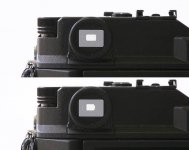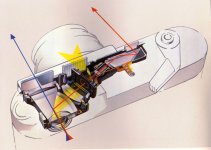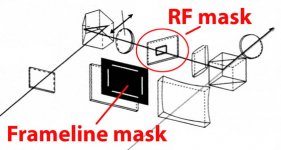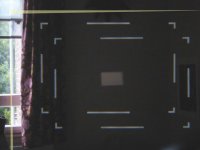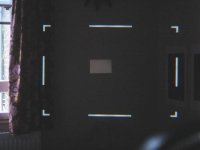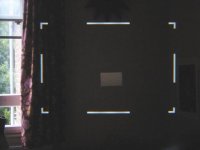jlw
Rangefinder camera pedant
Recently, on another thread, an R-D 1 user wrote:
Wait, I thought, I didn't think that the R-D 1 focus patch actually moves as you focus. It may look as if it's moving, because the framelines do move, and a focus patch that stayed stationary relative to the moving framelines might look as if it was moving instead. So, what's really happening in there?
I know this has been controversial in previous threads. So, in the spirit of my favorite TV show, Mythbusters, I made up a "rig" to try to find out.
I set my R-D 1 on a table and blocked it up so it would stay solidly in place. On it I mounted my 28/1.9 C-V Ultron, since it has the widest distance range of any of my lenses (its close focus limit of 0.7m is actually closer than the camera rangefinder couples -- the RF coupling arm stops coupling at about 0.85m.)
Five feet behind the camera eyepiece, I mounted a Nikon D100 equipped with an 80-200mm lens. I aligned the Nikon carefully so it was exactly in line with the R-D 1's finder eyepiece. When I zoomed in the SLR's lens, I could see the R-D 1's rangefinder patch within the eyepiece. If the RF patch moved at all, I should be able to see it easily by comparing its position within the eyepiece frame.
The picture attached shows what I saw: the upper part is at infinity, the lower part at 0.7m. See any difference in the position of the RF patch? Nope, neither did I. (The shape of the patch changes slightly -- you can see a rounded edge on it at the close-focus limit, as the RF image shifts and reaches the edge of the round field lens. But it's clear that the overall position of the patch stays right smack dab in the center of the finder. Myth busted.
But that's not exactly what the poster quoted had said. He said the RF patch moves "in the frame." That IS true, in a relative sense -- if the patch stays still, while the framelines move, then the position of the patch within the framelines will change as you focus. So, while the patch doesn't actually move, its position relative to the framelines does vary -- which indeed would make it more difficult to use the RF patch as an auxiliary viewfinder. Myth confirmed.
Now, will the Leica M8 really be any different? Well, oddly enough, I don't have an M8 handy on which to perform the same test! But if we look at the designs of the two cameras' rangefinders, we can see differences that suggest how they'll behave.
The second picture attached is a diagram of a Leica M6 rangefinder, which I borrowed from Erwin Puts' website. (I assume the M8's RF optics will be similar to these.) Follow the red arrow that traces the rangefinder-image light path, and look at the frameline mask in this diagram. You can see that the rectangular aperture that forms the sharp-edged rangefinder patch appears to be part of the same plate that forms the framelines. This plate moves diagonally as you focus, to cause the framelines to compensate for parallax. If the RF mask is really part of the same plate, then the rangefinder-patch rectangle should move in step with the framelines, just as our quoted post infers.
For comparison, the fourth attachment shows a diagram of the R-D 1 rangefinder, which I scanned from my Japanese R-D 1 World book. I've marked the parts of this diagram which show the RF mask and the frameline mask. As you can see, in the R-D 1 these masks are separate pieces, in different locations. The frameline mask moves diagonally to compensate for parallax, but there's no mechanism for moving the RF mask.
This explains why the R-D 1's rangefinder spot doesn't move as you focus, while the framelines do move... while, conversely, an M Leica's rangefinder spot and framelines would move together.
Whether it's "better" for the RF mask and framelines to move together or not is debatable -- it's probably a matter of personal taste. Personally, I like for the RF patch to stay put, so I always know where to look for it; someone who wants to use the RF patch as a viewfinder reference would naturally prefer it to move like the framelines do.
Other than that, I hope this "investigation" puts the question of R-D 1 rangefinder patch behavior to rest once and for all!
I... don't like to use accessory viewfinders, instead using the focus patch as a guide. This actually works pretty well except for the fact that the patch moves in the frame. The M8 won't do that and should be a lot better guide.
Wait, I thought, I didn't think that the R-D 1 focus patch actually moves as you focus. It may look as if it's moving, because the framelines do move, and a focus patch that stayed stationary relative to the moving framelines might look as if it was moving instead. So, what's really happening in there?
I know this has been controversial in previous threads. So, in the spirit of my favorite TV show, Mythbusters, I made up a "rig" to try to find out.
I set my R-D 1 on a table and blocked it up so it would stay solidly in place. On it I mounted my 28/1.9 C-V Ultron, since it has the widest distance range of any of my lenses (its close focus limit of 0.7m is actually closer than the camera rangefinder couples -- the RF coupling arm stops coupling at about 0.85m.)
Five feet behind the camera eyepiece, I mounted a Nikon D100 equipped with an 80-200mm lens. I aligned the Nikon carefully so it was exactly in line with the R-D 1's finder eyepiece. When I zoomed in the SLR's lens, I could see the R-D 1's rangefinder patch within the eyepiece. If the RF patch moved at all, I should be able to see it easily by comparing its position within the eyepiece frame.
The picture attached shows what I saw: the upper part is at infinity, the lower part at 0.7m. See any difference in the position of the RF patch? Nope, neither did I. (The shape of the patch changes slightly -- you can see a rounded edge on it at the close-focus limit, as the RF image shifts and reaches the edge of the round field lens. But it's clear that the overall position of the patch stays right smack dab in the center of the finder. Myth busted.
But that's not exactly what the poster quoted had said. He said the RF patch moves "in the frame." That IS true, in a relative sense -- if the patch stays still, while the framelines move, then the position of the patch within the framelines will change as you focus. So, while the patch doesn't actually move, its position relative to the framelines does vary -- which indeed would make it more difficult to use the RF patch as an auxiliary viewfinder. Myth confirmed.
Now, will the Leica M8 really be any different? Well, oddly enough, I don't have an M8 handy on which to perform the same test! But if we look at the designs of the two cameras' rangefinders, we can see differences that suggest how they'll behave.
The second picture attached is a diagram of a Leica M6 rangefinder, which I borrowed from Erwin Puts' website. (I assume the M8's RF optics will be similar to these.) Follow the red arrow that traces the rangefinder-image light path, and look at the frameline mask in this diagram. You can see that the rectangular aperture that forms the sharp-edged rangefinder patch appears to be part of the same plate that forms the framelines. This plate moves diagonally as you focus, to cause the framelines to compensate for parallax. If the RF mask is really part of the same plate, then the rangefinder-patch rectangle should move in step with the framelines, just as our quoted post infers.
For comparison, the fourth attachment shows a diagram of the R-D 1 rangefinder, which I scanned from my Japanese R-D 1 World book. I've marked the parts of this diagram which show the RF mask and the frameline mask. As you can see, in the R-D 1 these masks are separate pieces, in different locations. The frameline mask moves diagonally to compensate for parallax, but there's no mechanism for moving the RF mask.
This explains why the R-D 1's rangefinder spot doesn't move as you focus, while the framelines do move... while, conversely, an M Leica's rangefinder spot and framelines would move together.
Whether it's "better" for the RF mask and framelines to move together or not is debatable -- it's probably a matter of personal taste. Personally, I like for the RF patch to stay put, so I always know where to look for it; someone who wants to use the RF patch as a viewfinder reference would naturally prefer it to move like the framelines do.
Other than that, I hope this "investigation" puts the question of R-D 1 rangefinder patch behavior to rest once and for all!


